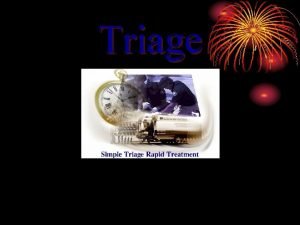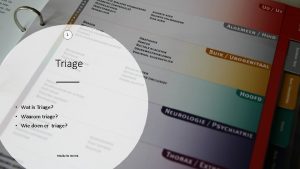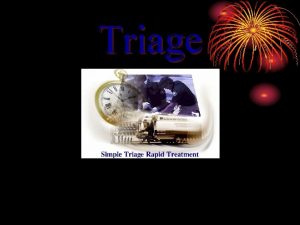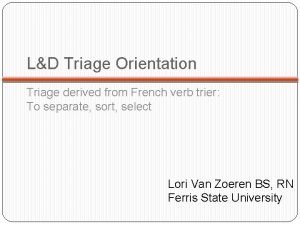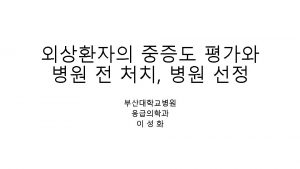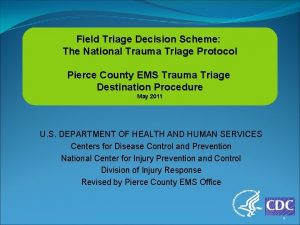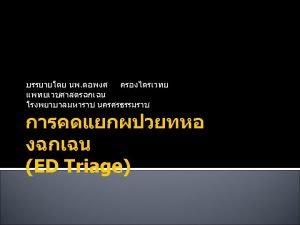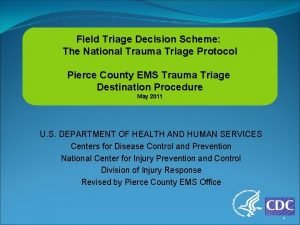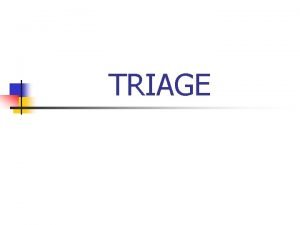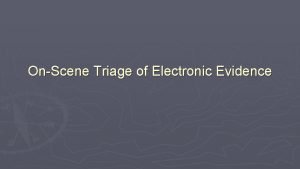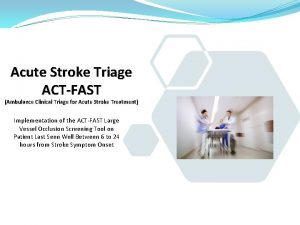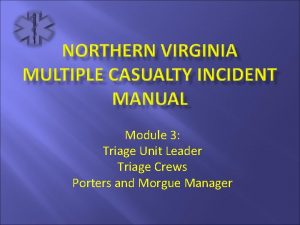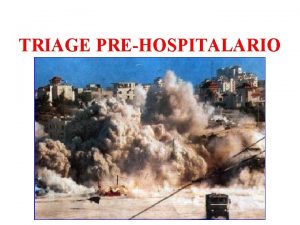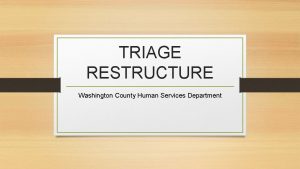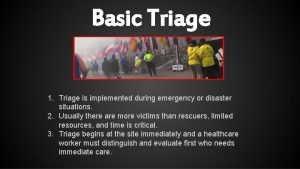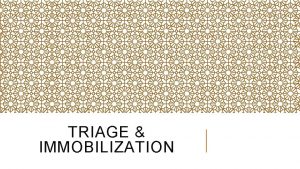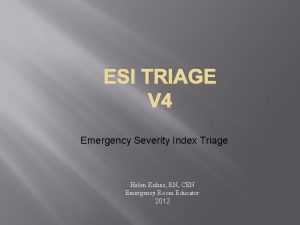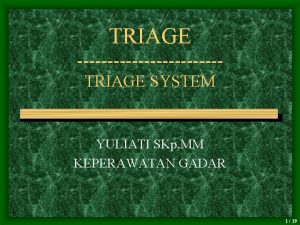Triage This is the lecture No 2 Source



























- Slides: 27

Triage This is the lecture No. 2 Source: Manual of emergency care 1 Dr. Ahmad Tubaishat September 2011

Triage The process of sorting patients as they present to the ED for care. Some cases need to be seen immediately, and some can wait safely. Decision based on the nurse assessment. Goal: place right patient in the right place at the right time for the right reason. 2 Dr. Ahmad Tubaishat September 2011

Triage systems: Three types identified, differ in: - Triage severity rating system - staffing - degree of assessment and documentation - extent to which triage staff initiate diagnostic and therapeutic interventions. 3 Dr. Ahmad Tubaishat September 2011

Triage 1 - Type I: Nonnurse, traffic director, receptionist greet pt, establish presenting complaint, based on that take a decision; "sick" : taken to treatment area and seen promptly or "not sick" In this system doc is minimal: name &C/C Risk: nonprofessional sort the case serious cases could unrecognized 4 Dr. Ahmad Tubaishat September 2011

Triage 2 - Type II: RN or physician performs a spot check. Take a quick look, limited information obtained, then pt assigned into 3 levels: emergent, urgent, or nonurgent. It is appropriate in low admissions rate hospital, when no need for 24 hr triage. 5 Dr. Ahmad Tubaishat September 2011

Triage 3 - Type III: Comprehensive, advance Experienced emergency nurse has a competency based triage orientation process. C/C , sub. and obj. data collected to support the rating decision. Initial findings documented in the record 6 Dr. Ahmad Tubaishat September 2011

Triage Two tired triage system: Because of high load in some hospitals the system adopted First nurse: greet the pt, determine C/C, assess ABC, decide if pt. need to be seen immediately or wait. Immediate care: go to treatment room Stable case: pt chart initiated by the first nurse, document C/C then direct the patient to assessment nurse Second nurse: more detailed and focused evaluation, initiate lab work and radiology according protocols. 7 Dr. Ahmad Tubaishat September 2011

Triage severity rating system: - Two level triage: Sick: urgent care needed not sick: no immediate care required. 8 Dr. Ahmad Tubaishat September 2011

Triage - Three level triage: Sometimes Identified by colors: red yellow and green or numbered 1 -3: - Emergent: immediate care, threat to life, limb, organ. e. g: cardiac arrest, major trauma, respiratory failure. Team response needed and reassessment is continuous. 9 Dr. Ahmad Tubaishat September 2011

Triage - Urgent: prompt care, pt wait safely several hours E. g: abdominal pain, renal calculi Reassessment needed q 30 min 10 Dr. Ahmad Tubaishat September 2011

Triage - Nourgent: need to be seen , but not critical and patient can wait safely e. g: soar throat, rash, conjunctivitis. Reassessment needed q 1 -2 hr. Poor inter and intra rater reliability between the 3 level 11 Dr. Ahmad Tubaishat September 2011

Triage - Four level triage: Breaking the emergent level into life threatening and emergency - Five level triage: Range from level 1 most acute to level 5 acute e. g: Manchester triage system: 12 Dr. Ahmad Tubaishat September 2011

Triage 13 Dr. Ahmad Tubaishat September 2011

Triage The emergency severity index: It is 5 level scale categories pt by severity and resources Severity: stability of vital function and potential to threat Resources: number of resources expected to consume before discharge 14 Dr. Ahmad Tubaishat September 2011

15 Dr. Ahmad Tubaishat September 2011

Triage The triage process: Initial triage assessment should be within 5 min of arrivals. - Across the room assessment: Begin when the nurse see the patient, based on general appearance, decide wither immediate care needed, pt taken directly to treatment room If stable, the triage process continue 16 Dr. Ahmad Tubaishat September 2011

Triage Observe: Airway patency, RR, external bleeding, LOC, pain, skin color, deformities, activity, clothing Listen: Abnormal airway sound, tone of voice, language Smell: Stool, urine, vomit, ketones, alcohol, infection, chemicals 17 Dr. Ahmad Tubaishat September 2011

Triage - The triage interview: Introduce ur self, ask for C/C, HPI, based on that focused assessment of the problem and measure V/S. level determined: either go immediately to a room for treatment or to waiting room. Communication is important 18 Dr. Ahmad Tubaishat September 2011

Triage Information seek: Who: pt demographics What: C/C Where: location of the problem & S/S When: time of symptom onset Why: precipitating factors How: how symptom affect normal function and how much 19 Dr. Ahmad Tubaishat September 2011

Triage - Triage V/S: It is a controversial area - Objective data: Physical examination related to C/C only not system by system or head to toe examination. - Triage severity rating: Based on C/C, subjective and objective data, triage nurse use knowledge, experience and guidelines to assign severity rating. Undertriaged pt receive delayed care and risk deterioration. Overtriaged divert resources. 20 Dr. Ahmad Tubaishat September 2011

Triage Safety and security Factors that contribute to violence: overcrowding, long waiting, violent gangs. Measures should be taken: panic buttons, restricted access doors, security cameras, police officers Monitor behavior Triage nurse shouldn’t place themselves or others at risk. 21 Dr. Ahmad Tubaishat September 2011

Triage documentation: Clear concise, support the assigned severity rating. Depend on the policy: usually there is area in the chart for triage notes. SOPIE. 22 Dr. Ahmad Tubaishat September 2011

Triage Infection control: Triage nurse should use STD infection control precautions Hand washing between pt. It is an portal of entry for contagious diseases: appropriate precautions 23 Dr. Ahmad Tubaishat September 2011

Triage Telephone triage: Verbal interview and making assessment of the health status of the caller by trained tel triage nurse. 24 Dr. Ahmad Tubaishat September 2011

Triage qualifications: - RN, min 6 months of emergency experience - formal triage education with supervised preceptorship - ACLS cert - Emergency nursing peds course - trauma nursing course - emergency nurse cert - effective communications, flexible - ability to use nursing process effectively - role model and representative - excellent decision making skills 25 Dr. Ahmad Tubaishat September 2011

Triage Patient assessment: Component of the initial assessment Primary assessment: - A: Airway - B: Breathing - C: Circulation - D: Disability, AVPU (alert, verbal, pain, unresponsive) - E: Exposure/ Environmental control 26 Dr. Ahmad Tubaishat September 2011

Triage Secondary assessment: - F: Full set of vitals: Temp, Pulse, Respiration, RR, o 2 sat, weight - G: Give comfort measures: PQRST for pain - H: History (S& O: C/C , HPI, medical history, meds, labs, family hx) and head to toe assessment - I: Inspect posterior surfaces 27 Dr. Ahmad Tubaishat September 2011
 01:640:244 lecture notes - lecture 15: plat, idah, farad
01:640:244 lecture notes - lecture 15: plat, idah, farad độ dài liên kết
độ dài liên kết 101012 bằng
101012 bằng Thiếu nhi thế giới liên hoan
Thiếu nhi thế giới liên hoan Tia chieu sa te
Tia chieu sa te Chúa yêu trần thế alleluia
Chúa yêu trần thế alleluia Một số thể thơ truyền thống
Một số thể thơ truyền thống Hệ hô hấp
Hệ hô hấp Các số nguyên tố là gì
Các số nguyên tố là gì Công của trọng lực
Công của trọng lực đặc điểm cơ thể của người tối cổ
đặc điểm cơ thể của người tối cổ Tỉ lệ cơ thể trẻ em
Tỉ lệ cơ thể trẻ em Các châu lục và đại dương trên thế giới
Các châu lục và đại dương trên thế giới ưu thế lai là gì
ưu thế lai là gì Thẻ vin
Thẻ vin Môn thể thao bắt đầu bằng chữ f
Môn thể thao bắt đầu bằng chữ f Tư thế ngồi viết
Tư thế ngồi viết Cái miệng xinh xinh thế chỉ nói điều hay thôi
Cái miệng xinh xinh thế chỉ nói điều hay thôi Hình ảnh bộ gõ cơ thể búng tay
Hình ảnh bộ gõ cơ thể búng tay Từ ngữ thể hiện lòng nhân hậu
Từ ngữ thể hiện lòng nhân hậu Trời xanh đây là của chúng ta thể thơ
Trời xanh đây là của chúng ta thể thơ Tư thế ngồi viết
Tư thế ngồi viết Voi kéo gỗ như thế nào
Voi kéo gỗ như thế nào Thế nào là giọng cùng tên
Thế nào là giọng cùng tên Thơ thất ngôn tứ tuyệt đường luật
Thơ thất ngôn tứ tuyệt đường luật Hổ đẻ mỗi lứa mấy con
Hổ đẻ mỗi lứa mấy con đại từ thay thế
đại từ thay thế Thế nào là hệ số cao nhất
Thế nào là hệ số cao nhất




























